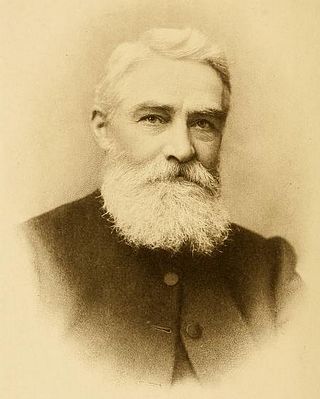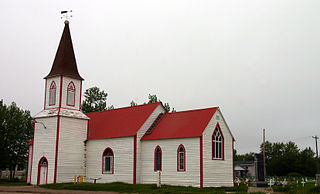
The Cree are a North American Indigenous people. They live primarily in Canada, where they form one of the country's largest First Nations. More than 350,000 Canadians are Cree or have Cree ancestry. The major proportion of Cree in Canada live north and west of Lake Superior, in Ontario, Manitoba, Saskatchewan, Alberta, and the Northwest Territories. About 27,000 live in Quebec.

Cree is a dialect continuum of Algonquian languages spoken by approximately 86,475 indigenous people across Canada in 2021, from the Northwest Territories to Alberta to Labrador. If considered one language, it is the aboriginal language with the highest number of speakers in Canada. The only region where Cree has any official status is in the Northwest Territories, alongside eight other aboriginal languages. There, Cree is spoken mainly in Fort Smith and Hay River.

Edmund James Peck, known in Inuktitut as Uqammaq, was an Anglican missionary in the Canadian North on the Quebec coast of Hudson Bay and on Baffin Island. He founded the first permanent mission on Baffin Island, Nunavut. He developed Inuktitut syllabics, derived from the Cree syllabary and the first substantial English-Inuktitut dictionary.

Canadian syllabic writing, or simply syllabics, is a family of writing systems used in a number of Indigenous Canadian languages of the Algonquian, Inuit, and (formerly) Athabaskan language families. These languages had no formal writing system previously. They are valued for their distinctiveness from the Latin script and for the ease with which literacy can be achieved. For instance, by the late 19th century the Cree had achieved what may have been one of the highest rates of literacy in the world.

Cree syllabics are the versions of Canadian Aboriginal syllabics used to write Cree dialects, including the original syllabics system created for Cree and Ojibwe. There are two main varieties of syllabics for Cree: Western Cree syllabics and Eastern Cree syllabics. Syllabics were later adapted to several other languages. It is estimated that over 70,000 Algonquian-speaking people use the script, from Saskatchewan in the west to Hudson Bay in the east, the US border to Mackenzie and Kewatin in the north.
The Opaskwayak Cree Nation is a First Nations band government located in Manitoba, Canada. The main OCN reserve is regarded as one of three distinct communities that comprise "The Pas area" in northern Manitoba, with the two others being the Town of The Pas and the Rural Municipality of Kelsey.
The Severn Ojibwa or the Oji-Cree language is the indigenous name for a dialect of the Ojibwe language spoken in a series of Oji-Cree communities in northern Ontario and at Island Lake, Manitoba, Canada. Ojibwa is a member of the Algonquian language family, itself a member of the Algic language family.

The Swampy Cree people, also known by their autonyms Néhinaw, Maskiki Wi Iniwak, Mushkekowuk,Maškékowak, Maskegon or Maskekon or by exonyms including West Main Cree,Lowland Cree, and Homeguard Cree, are a division of the Cree Nation occupying lands located in northern Manitoba, along the Saskatchewan River in northeastern Saskatchewan, along the shores of Hudson Bay and adjoining interior lands south and west as well as territories along the shores of Hudson and James Bay in Ontario. They are geographically and to some extent culturally split into two main groupings, and therefore speak two dialects of the Swampy Cree language, which is an "n-dialect":

John Horden was the first Anglican Bishop of Moosonee, Canada, who for more than forty years led services in Cree, Inuit and other languages of his parishioners.
The Central Algonquian languages are commonly grouped together as a subgroup of the larger Algonquian family, itself a member of the Algic family. Though the grouping is often encountered in the literature, it is an areal grouping, not a genetic grouping. In other words, the languages are grouped together because they were spoken near one another, not because they are more closely related to one another than to other Algonquian languages. Within the Algonquian family, only Eastern Algonquian is a valid genealogical group.

St. Thomas' Anglican Church is an historic Carpenter Gothic style Anglican church edifice built by the Hudson's Bay Company in Moose Factory, Ontario, Canada.
The complete Bible has been translated into three of the dialects of Inupiat language, the New Testament in two more and portions in another.
Work on translation of the Bible into the Kazakh language began with the work of Charles Fraser of the Scottish Missionary Society. Fraser's translation of Matthew was published in 1818, and the New Testament in 1820 by the Russian Bible Society. J. M. E. Gottwald, a professor at Kazan University, revised it, and this was published in 1880 by the British and Foreign Bible Society in Kazan, and it was republished in 1887, and 1910. George W. Hunter, of the China Inland Mission in Ürümqi, considered this translation to be "a good translation, into Astrahan-Turki", he does not seem to have considered it to be Kazakh. Darlow and Moule say that it was intended for Kyrgyz in the neighbourhood of Orenburg, and the language was sometimes called "Orenburg Tatar". According to Rev. W. Nicholson of the Royal Asiatic Society in St Petersburg this translation was intended for "The Kirghese hordes—Great, Little, and Middle, as they are called—[who] occupy various regions in Southern Siberia, Central Asia, and west of the Caspian Sea." George A. King says Fraser's translation was into the language of the "Western Kirghiz or Kirghiz-Kazak, though they disown the name Kirghiz".
Part of the Bible was first available in the Kurdish language in 1856. Modern translations of the whole Bible are available in standard Kurmanji and Sorani, with many portions in other dialects.
Biblical translations into the indigenous languages of North and South America have been produced since the 16th century.

The Athabaskan language family is divided into the Northern Athabaskan, Pacific Coast Athabaskan and Southern Athabaskan groups. The full Bible has been translated into two Athabaskan languages, and the complete New Testament in five more. Another five have portions of the Bible translated into them. There are no Pacific Coast Athabaskan languages with portions of the Bible translated into them.
The Bible, or portions of it, have been translated into over 1,000 languages of Africa.
Traditionally Russia used the Old Church Slavonic language and Slavonic Bible, and in the modern era Bible translations into Russian. The minority languages of Russia usually have a much more recent history, many of them having been commissioned or updated by the Institute for Bible Translation.
John William Tims was a DD was Archdeacon of Calgary from 1898 to 1912.








